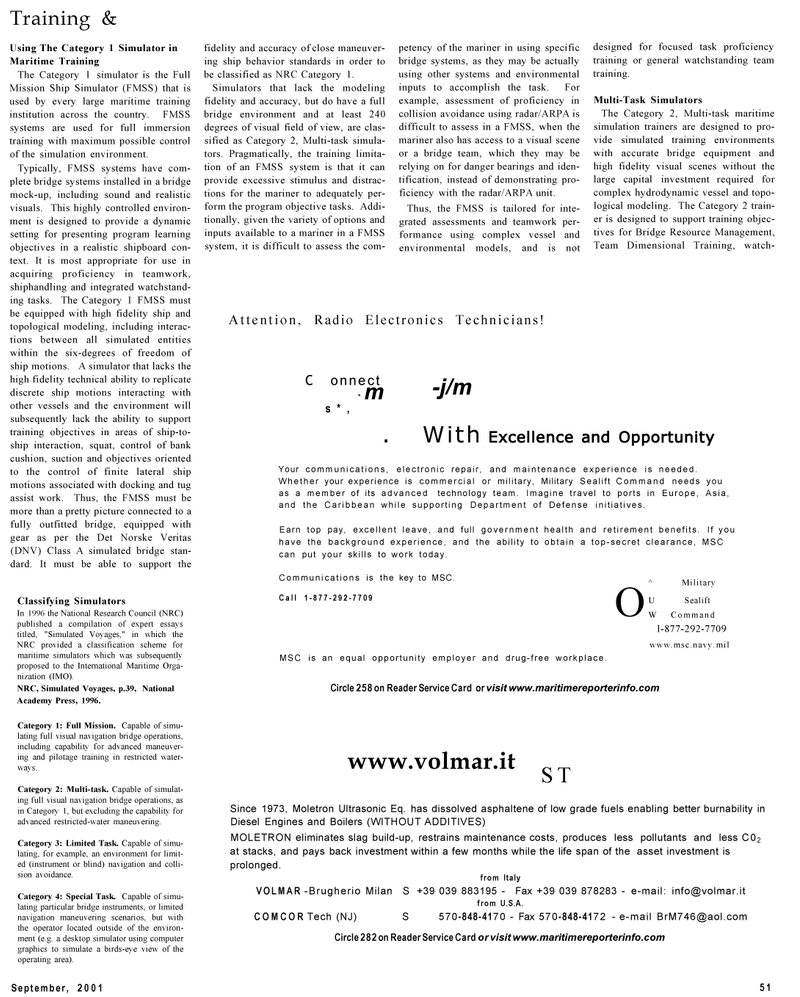
Page 51: of Maritime Reporter Magazine (September 2001)
Read this page in Pdf, Flash or Html5 edition of September 2001 Maritime Reporter Magazine
Training &
Using The Category 1 Simulator in
Maritime Training
The Category 1 simulator is the Full
Mission Ship Simulator (FMSS) that is used by every large maritime training institution across the country. FMSS systems are used for full immersion training with maximum possible control of the simulation environment.
Typically, FMSS systems have com- plete bridge systems installed in a bridge mock-up, including sound and realistic visuals. This highly controlled environ- ment is designed to provide a dynamic setting for presenting program learning objectives in a realistic shipboard con- text. It is most appropriate for use in acquiring proficiency in teamwork, shiphandling and integrated watchstand- ing tasks. The Category 1 FMSS must be equipped with high fidelity ship and topological modeling, including interac- tions between all simulated entities within the six-degrees of freedom of ship motions. A simulator that lacks the high fidelity technical ability to replicate discrete ship motions interacting with other vessels and the environment will subsequently lack the ability to support training objectives in areas of ship-to- ship interaction, squat, control of bank cushion, suction and objectives oriented to the control of finite lateral ship motions associated with docking and tug assist work. Thus, the FMSS must be more than a pretty picture connected to a fully outfitted bridge, equipped with gear as per the Det Norske Veritas (DNV) Class A simulated bridge stan- dard. It must be able to support the fidelity and accuracy of close maneuver- ing ship behavior standards in order to be classified as NRC Category 1.
Simulators that lack the modeling fidelity and accuracy, but do have a full bridge environment and at least 240 degrees of visual field of view, are clas- sified as Category 2, Multi-task simula- tors. Pragmatically, the training limita- tion of an FMSS system is that it can provide excessive stimulus and distrac- tions for the mariner to adequately per- form the program objective tasks. Addi- tionally, given the variety of options and inputs available to a mariner in a FMSS system, it is difficult to assess the com- petency of the mariner in using specific bridge systems, as they may be actually using other systems and environmental inputs to accomplish the task. For example, assessment of proficiency in collision avoidance using radar/ARPA is difficult to assess in a FMSS, when the mariner also has access to a visual scene or a bridge team, which they may be relying on for danger bearings and iden- tification, instead of demonstrating pro- ficiency with the radar/ARPA unit.
Thus, the FMSS is tailored for inte- grated assessments and teamwork per- formance using complex vessel and environmental models, and is not designed for focused task proficiency training or general watchstanding team training.
Multi-Task Simulators
The Category 2, Multi-task maritime simulation trainers are designed to pro- vide simulated training environments with accurate bridge equipment and high fidelity visual scenes without the large capital investment required for complex hydrodynamic vessel and topo- logical modeling. The Category 2 train- er is designed to support training objec- tives for Bridge Resource Management,
Team Dimensional Training, watch-
Classifying Simulators
In 1996 the National Research Council (NRC) published a compilation of expert essays titled, "Simulated Voyages," in which the
NRC provided a classification scheme for maritime simulators which was subsequently proposed to the International Maritime Orga- nization (IMO).
NRC, Simulated Voyages, p.39, National
Academy Press, 1996.
Category 1: Full Mission. Capable of simu- lating full visual navigation bridge operations, including capability for advanced maneuver- ing and pilotage training in restricted water- ways.
Category 2: Multi-task. Capable of simulat- ing full visual navigation bridge operations, as in Category 1, but excluding the capability for advanced restricted-water maneuvering.
Category 3: Limited Task. Capable of simu- lating, for example, an environment for limit- ed (instrument or blind) navigation and colli- sion avoidance.
Category 4: Special Task. Capable of simu- lating particular bridge instruments, or limited navigation maneuvering scenarios, but with the operator located outside of the environ- ment (e.g. a desktop simulator using computer graphics to simulate a birds-eye view of the operating area).
Attention, Radio Electronics Technicians!
C onnect * m -j/m s*, . With Excellence and Opportunity
Your communications, electronic repair, and maintenance experience is needed.
Whether your experience is commercial or military, Military Sealift Command needs you as a member of its advanced technology team. Imagine travel to ports in Europe, Asia, and the Caribbean while supporting Department of Defense initiatives.
Earn top pay, excellent leave, and full government health and retirement benefits. If you have the background experience, and the ability to obtain a top-secret clearance, MSC can put your skills to work today.
Communications is the key to MSC.
Call 1-877-292-7709
MSC is an equal opportunity employer and drug-free workplace.
O ^ Military U Sealift W Command l-877-292-7709 www.msc.navy.mil
Circle 258 on Reader Service Card or visit www.maritimereporterinfo.com www.volmar.it ST
Since 1973, Moletron Ultrasonic Eq. has dissolved asphaltene of low grade fuels enabling better burnability in
Diesel Engines and Boilers (WITHOUT ADDITIVES)
MOLETRON eliminates slag build-up, restrains maintenance costs, produces less pollutants and less C02 at stacks, and pays back investment within a few months while the life span of the asset investment is prolonged. from Italy
VOLMAR -Brugherio Milan S +39 039 883195 - Fax +39 039 878283 - e-mail: [email protected] from U.S.A.
COMCOR Tech (NJ) S 570-848-4170 - Fax 570-848-4172 - e-mail [email protected]
Circle 282 on Reader Service Card or visit www.maritimereporterinfo.com
September, 2001 51

 50
50

 52
52
